Seven Questions Over Breakfast
with Lisa Horstman
 July 14th, 2009 by jules
July 14th, 2009 by jules
 I would want to chat with author/illustrator Lisa Horstman, no matter where she lived, because I have been familiar with and have enjoyed her books for years now and because this is the first time here at 7-Imp that I’m having a conversation with an illustrator whose latest picture book, Squawking Matilda (Marshall Cavendish, April 2009), includes stop-motion hand-crafted puppets combined with digital art work. Yup, it’s a first, and I have to say her answer to the “process” question is one of my favorites thus far in all my breakfast interviews with illustrators. Ball-and-socket brass armatures. A jeweler’s drill press. Microknitting. Wee little puppet clothes. And wee little mask latex shoes. I find it all quite fascinating.
I would want to chat with author/illustrator Lisa Horstman, no matter where she lived, because I have been familiar with and have enjoyed her books for years now and because this is the first time here at 7-Imp that I’m having a conversation with an illustrator whose latest picture book, Squawking Matilda (Marshall Cavendish, April 2009), includes stop-motion hand-crafted puppets combined with digital art work. Yup, it’s a first, and I have to say her answer to the “process” question is one of my favorites thus far in all my breakfast interviews with illustrators. Ball-and-socket brass armatures. A jeweler’s drill press. Microknitting. Wee little puppet clothes. And wee little mask latex shoes. I find it all quite fascinating.
But, as an added extra bonus, Lisa is from Knoxville, Tennessee! In many ways, East Tennessee will always be home to me, and I’m thrilled to be shining the spotlight on a Tennessee author/illustrator. I don’t know why I didn’t invite her over for breakfast sooner, y’all. Seriously. 7-Imp evidently has readers all over the world, and that’s great. But it’s so nice to be having a breakfast chat for once with someone just a little over two-hundred miles away from me, as I blog in my little kitchen here in middle Tennessee. It’s great to see some Tennessee talent. Can someone give me a wa and hoo? And a WOOT! Okay, there. Got that out of my system.
As you’ll read below, Lisa won the Dr. Seuss Picture Book Award in 1994 for her first children’s book, Fast Friends, along with a publishing contract from Random House. Since that time, she has worked as a designer for a travel magazine; art director for Knoxville’s Metro Pulse; and published several picture books for the National Park Service. Currently, she is a part-time designer for the Great Smoky Mountains Association.
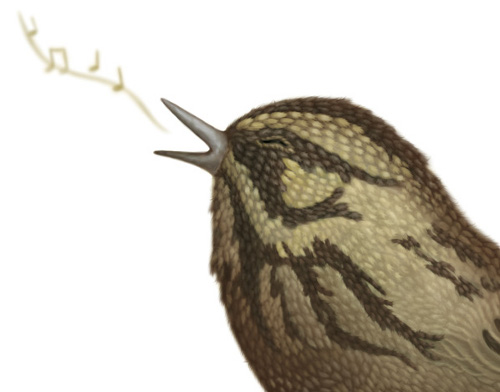
Squawking Matilda, her newest title, tells the story of Mae, a young girl keen on starting special projects — but not quite keen on finishing them. When her Aunt Susan asks her in a letter to take care of her chicken, the “sassiest, smartest, most bee-yoo-tiful chicken,” Mae is thrilled. She names her Matilda. But before she knows it, she realizes how much work is involved: “Work, work, work! It was almost too much for Mae. There were times when Matilda was too scrappy.” Things go downhill pretty quickly. When Aunt Susan announces she’ll be visiting, Mae has three weeks to make everything better. School Library Journal wrote, “Handcrafted puppets…are posed, photographed, and digitally colored to give this charming selection a down-to-earth quality that matches the story perfectly. This is a fun choice about a well-meaning but easily distracted young heroine. It will make readers chuckle aloud.”
Lisa’s Author Note summarizes her choice-of-medium for this title:
Each puppet illustration in this book began as a stainles steel inner scaffolding, or armature. A flexible body was created around it with wool felting, and hands and heads were sculpted and baked with polymer clay. The finished posable puppet was dressed in clothing either knit or sewn by hand and then photographed against a neutral background. Color was added digitally to the image of the puppet and superimposed against a backdrop that was painted earlier and scanned separately. Then the artist took a nap.



Lisa’s joining me this morning for “coffee with cream and sweetener. Porridge with raisins and milk. One fried egg over easy. I prefer chocolate cake for breakfast, alas.” Aw, why not? Let’s do it. I’ll start baking the chocolate cake—I’ll even make the Emily-Gravett-inspired Chocolate Guinness version, mmm—while I get the basics from Lisa and while the coffee’s brewing. I thank her for stopping by and for sharing artwork from her previous titles—as well as more from Matilda—scattered here throughout the interview.
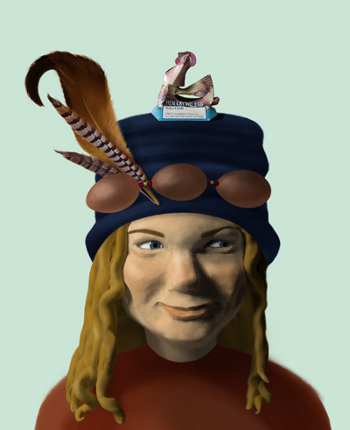 7-Imp: Are you an illustrator or author/illustrator?
7-Imp: Are you an illustrator or author/illustrator?
Lisa: Artistic Minx. Okay, author/illustrator.
7-Imp: Can you list your books-to-date?
Lisa:
* We’re Going to the Mountains (illustrator)
* Gracie Goat’s Big Bike Race (illustrator)
* The Smokies Yukky Book (illustrator)
* Wee Ones
* One Baby Mountain Goat (illustrator)
* The Great Smoky Mountain Salamander Ball
* Fast Friends
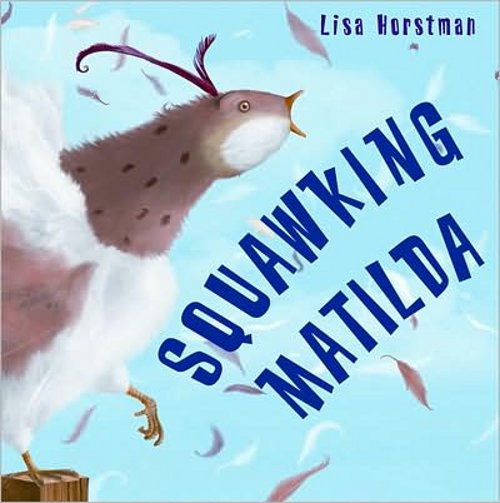

7-Imp: What is your usual medium, or -– if you use a variety -– your preferred one?
Lisa: It depends on the project. Oil on board for some, puppets with digitally-painted background art for others.
7-Imp: Where are your stompin’ grounds?
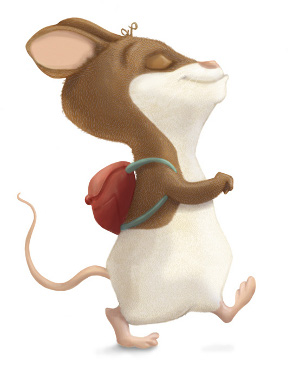 Lisa: Knoxville, TN—or as we like to call it, KnoxVegas.
Lisa: Knoxville, TN—or as we like to call it, KnoxVegas.
7-Imp: Can you briefly tell us about your road to publication?
Lisa: I won a publishing contract and $25,000 for a picture book submission. Random House held a contest in 1992 for unpublished potential picture book author/illustrators. It was in honor of Dr. Seuss, but the plan was not to find the next Dr. Seuss. Rather, it was to discover a new talent to nourish in the picture book world. Boy, talk about being thrown into the deep end to learn how to swim…
7-Imp: Can you please point us to your web site and/or blog?
Lisa: Web site: www.lisahorstman.com. Blog: www.lisahorstman.blogspot.com.
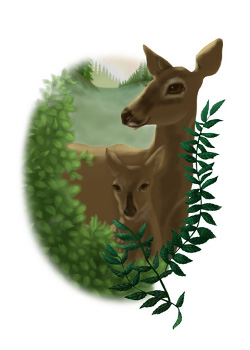 7-Imp: If you do school visits, tell us what they’re like.
7-Imp: If you do school visits, tell us what they’re like.
Lisa: I haven’t done as many as I used to; they take a lot of time and planning on my part and are essentially like doing a stage performance for me—exhausting! But they can be fun, if the groups are kept small; that way I can interact more with the kids. With my latest book, Squawking Matilda, I’ve illustrated it with stopmotion animation-style puppets, so I bring a couple of those along and talk about how they’re made. I also show a couple of more traditionally-styled paintings to talk about how they’re different from paintings created digitally. I show the kids how I combine the photographs of the posed puppets with digital paintings; I use a Cintiq tablet (a Wacom tablet with a digital stylus pen; you can draw and paint directly on its screen with the stylus), and I plug it into my laptop to show the kids how it all works.

A couple of stories:
-— Kids will be so anxious to ask a question, and then when I call on them they often will forget what the question was.
—- Usually, if I mention that I have cats, they all will want to talk about THEIR cats. Once, I told them about my first cat, Dave, and a kid asked, “Is your cat weird?”
—- I did a library visit once in Nashville that was inner city. When the cab driver was taking me there, she kept asking me, “Are you sure this is where you’re supposed to go?” The library was kind of like a bright little oasis for those kids, and the librarian did the best she could to create a great atmosphere. She kept a pretty close eye on the kids and wouldn’t let them play in the front yard of the library. I remember hearing roosters crowing nearby, and she said someone kept fighting cocks in a pen down the street.
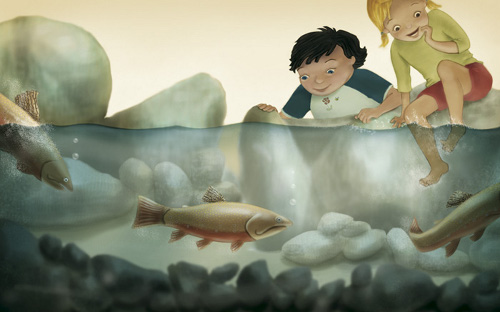


7-Imp: If you teach illustration, by chance, tell us how that influences your work as an illustrator.
 Lisa: I don’t teach illustration, but I used to assign a lot of illustrations as a magazine art director. One company I worked for, Whittle Communications, was really into using some of the top illustrators for their magazines, but they also were interested in finding new talent. By assigning this range of work, I was able to learn firsthand how to professionally submit illustrations, as well as how to work with agents. It was always so fun to see finished pieces of art come in, to study the techniques the artists used.
Lisa: I don’t teach illustration, but I used to assign a lot of illustrations as a magazine art director. One company I worked for, Whittle Communications, was really into using some of the top illustrators for their magazines, but they also were interested in finding new talent. By assigning this range of work, I was able to learn firsthand how to professionally submit illustrations, as well as how to work with agents. It was always so fun to see finished pieces of art come in, to study the techniques the artists used.
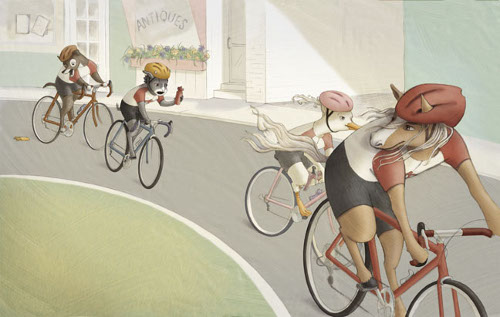
7-Imp: Any new titles/projects you might be working on now that you can tell us about?
Lisa: I’m currently working on two picture books; one is about a monkey family, the other is more history-oriented and may have more of a storybook format.

 Our table’s set. Coffee’s on, and cake’s ready. Time for our breakfast chat. Again, I thank Lisa for stopping by, and let’s keep at it…
Our table’s set. Coffee’s on, and cake’s ready. Time for our breakfast chat. Again, I thank Lisa for stopping by, and let’s keep at it…
1. 7-Imp: What exactly is your process when you are illustrating a book? You can start wherever you’d like when answering: getting initial ideas, starting to illustrate, or even what it’s like under deadline, etc. Do you outline a great deal of the book before you illustrate or just let your muse lead you on and see where you end up?
Lisa: First I have an idea for a story, and I begin to visualize what the characters could look like. I start doing character sketches to define facial features, body shapes, how they dress, etc. I do research, too.
I start writing down story ideas, kind of a very loose outline (if even that) with some scenarios. Sometimes I complete the story now, so I can take a break from it and look at it with fresh eyes later on.
After I fine-tune the character sketches, I draw how the puppet armature, or “bones,” will be proportioned and decide if I’ll need to create a simple armature or a more complicated ball-and-socket armature. Oftentimes, I can get away with a simpler wire armature, but if the figure is a main character which will be posed quite a bit, I opt for a ball-and-socket armature, which is more durable.

 I start sculpting the puppet head and hands. I’ve used Sculpey in the past, but I’ve dropped so many Sculpey heads on the floor and chipped them or cracked them that I decided to find a harder polymer clay. Fimo Doll Puppen works really well for me. I’ve dropped lots of those sculpts and they haven’t even chipped.
I start sculpting the puppet head and hands. I’ve used Sculpey in the past, but I’ve dropped so many Sculpey heads on the floor and chipped them or cracked them that I decided to find a harder polymer clay. Fimo Doll Puppen works really well for me. I’ve dropped lots of those sculpts and they haven’t even chipped.
Now I start making the armatures. The simple twisted-wire ones are pretty quick, but the ball-and-socket brass armatures require more time, usually a total of twenty-four hours or more to cut, drill, file, solder, and assemble the parts. It’s actually pretty fun, if you allow yourself plenty of time and don’t rush things. I was pretty intimidated about using a drill press at first, but  I found a jeweler’s drill press is easier to operate since it’s fairly small. If you can use a sewing machine, you can use one of these things. But if I ever decide to try making a stainless steel armature, that’s whole ‘nother ball of wax altogether.
I found a jeweler’s drill press is easier to operate since it’s fairly small. If you can use a sewing machine, you can use one of these things. But if I ever decide to try making a stainless steel armature, that’s whole ‘nother ball of wax altogether.
Once the armature is assembled, I’m ready to wrap it with wool fibers and begin felting them with a felting needle. The needles come in different gauges, are very sharp, and have small barbs near the tips. Accidently tabbing yourself in the finger with one is not fun, but it sure wakes you up. You sit there and repeatedly stab the wool fibers until gradually they become wool felting. You can also soak the fibers in soapy water, but that didn’t work for my needs.

Clothes come next. Oftentimes, I either create my own pattern or find old doll patterns and size them to fit the puppets. I usually sketch the clothes design first, including the colors I want to use, and then figure out a pattern. With puppet clothes, I either try to find fabrics with small patterns or else I’ll make my own fabric pattern and print it out on plain fabric, using an inkjet printer. I’ve also tried microknitting, which involves using tiny knitting needles. I made a pair of stripey black and white tights for one of my puppets. Because I’m stupid that way. It’s pretty hard, but it’s rewarding…in a twisted way. I don’t plan to attempt anything more complicated—I’m leaving that to my friend Adrienne Martini, who wants to try microknitting and is a much more experienced knitter than myself.
Shoes are next. I did the shoes digitally in Squawking Matilda, but for the monkey family puppets I experimented with making shoes out of mask latex. First, you have to sculpt the shoes out of oil-based clay and then do a plaster casting of the shoes. Once the plaster mold is ready, you pour a thin coating of mask latex inside the plaster mold and wait for it to dry out. Voila! Puppet shoes! I found a special mask paint that will adhere to the latex, so I can paint them any color I want.

Now I go back to the story, refine it, and think of how to split up the text into a book format, or sketch dummy. I think about story pacing, what words are unnecessary if the concept can be shown in the illustration, and simplify the text as much as I can. That’s the special thing about picture books; the text can’t stand alone, and neither can the artwork. Both are necessary to tell the story more completely. I often study how graphic novels are put together, as well as cinematography and editing in movies.
 I start sketching scenarios for the book and think about the art formatting—will it be a full page, a spread, or a small, spot illustration? Will the sizes vary throughout the book? How complicated does the illustration need to be to help communicate the story? How do I want to light it when I get ready to photograph the puppets? What colors will I use to communicate certain emotions?
I start sketching scenarios for the book and think about the art formatting—will it be a full page, a spread, or a small, spot illustration? Will the sizes vary throughout the book? How complicated does the illustration need to be to help communicate the story? How do I want to light it when I get ready to photograph the puppets? What colors will I use to communicate certain emotions?
Once the sketch dummy is ready (with text in place), I send it—along with the typed manuscript—to my agent. Usually, we’ve already talked about my book idea, but she hasn’t seen any text yet. She looks it over, makes suggestions (she’s a former children’s book editor, and I trust her), and I go back and work some more. In the meantime, I’ve chosen a couple of the sketches to take to final art; I’ll do a background illustration, usually digitally with Photoshop, pose and photograph the puppets, and add those images to the background illustration, adding digital color to the puppet forms. Meanwhile, hopefully both my agent and I have reached a point where we’re both happy with where the story’s at. I submit two or three finished pieces of artwork to her, and she takes the artwork, manuscript, and book dummy around to various publishers to see if anyone’s interested in publishing. It usually takes a while, because even if an editor is interested in the submission, it must be presented formally to the editorial and marketing staff, where they discuss the book and whether they think it could sell, among other things.

If they decide to publish, then it’s more work ahead; I’ll probably have revisions to the text and sketches and then will have to do final art for the entire book.
This process is a combination of different art forms. I’ve always been interested in stop motion animation, and the puppets fascinated me. I didn’t want to have to craft entire sets, however, so I decided to illustrate the backgrounds and photograph the puppets separately. After that it was a process of experimenting, seeing what worked and what didn’t…just like anything else. I learned much about doll and puppet craft, picking and choosing elements to fit my needs. It’s all a hodgepodge of different things I’ve learned how to do over the years that strangely came together for me. With the internet, it’s so much easier to learn how to do this stuff, but I also relied on the library for books on doll craft. I studied how things are crafted for recent stop motion animation features, such as Coraline (which is where I got the microknitting idea). And it feels really good to use a combination of hand-crafted art, alongside digital processes.


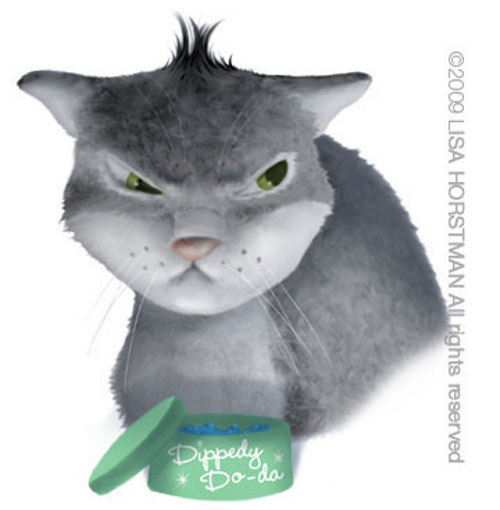
Like…giving Cat a new hairdo . . .”
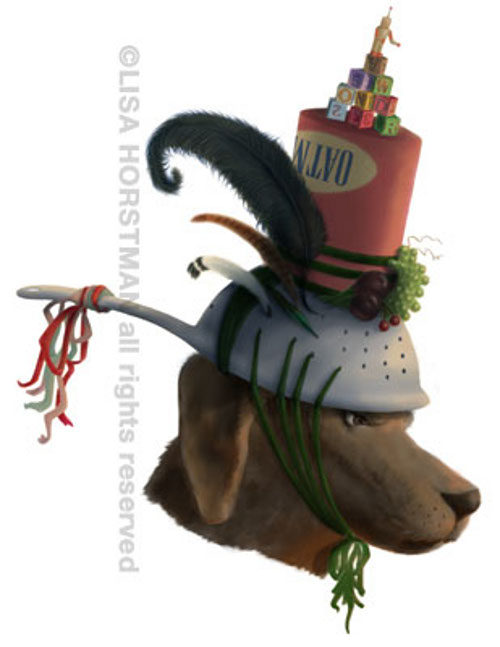
2. 7-Imp: Describe your studio or usual work space for us.
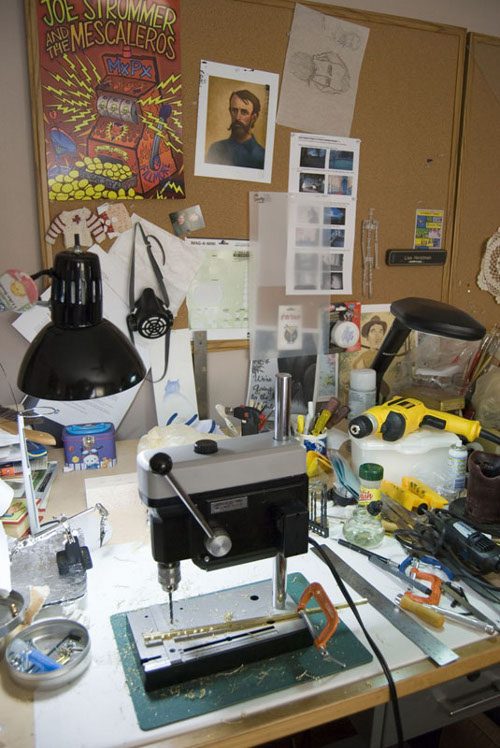
Lisa: Every day I look at my studio walls and ask myself, “Why are my studio walls pink?” Then I answer myself, “Because they were pink when you moved in, and now it would take so much time and effort to move everything and unplug everything and take everything off the walls.” Then I just shrug my shoulders and leave everything alone. I do manage to hoover up the roaming cat hair tumbleweeds. I could probably build a new cat out of some of them.
But I’m lucky to have this much space and light. The room is roughly 15 x 20 ft and holds an old wooden teacher’s desk for my computer, a drawing table, storage cabinets, a ratty couch and chair, which our three cats use for their wild scratchin’ parties, and bookshelves.
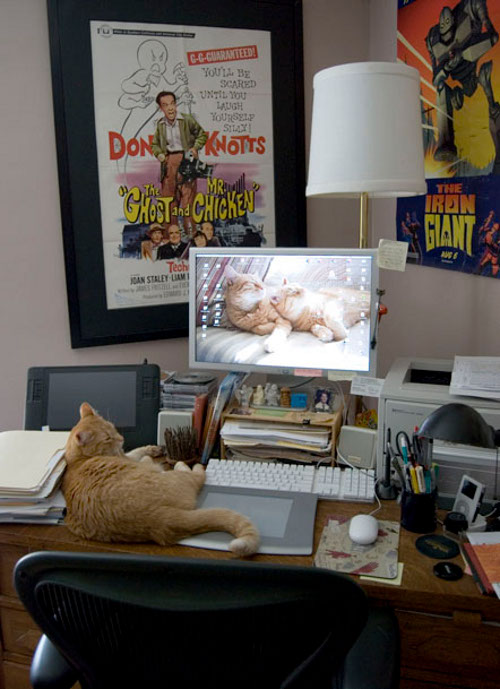

3. 7-Imp: As book lovers, it interests us: What books or authors and/or illustrators influenced you as an early reader?
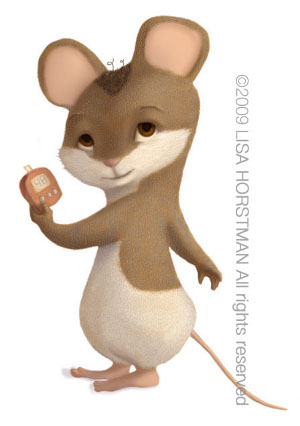 Lisa: Much of my influences were from middle-grade books. I loved Louise Fitzhugh’s Harriet the Spy, Little Women by Louisa May Alcott, the Katie John books by Mary Calhoun, all of the Beezus and Ramona/Henry Huggins books by Beverly Cleary, and Robert McCloskey’s Homer Price books. I also read quite a few Nancy Drew mysteries and all of the Little House on the Prairie books. I loved Mark Twain, too.
Lisa: Much of my influences were from middle-grade books. I loved Louise Fitzhugh’s Harriet the Spy, Little Women by Louisa May Alcott, the Katie John books by Mary Calhoun, all of the Beezus and Ramona/Henry Huggins books by Beverly Cleary, and Robert McCloskey’s Homer Price books. I also read quite a few Nancy Drew mysteries and all of the Little House on the Prairie books. I loved Mark Twain, too.
As for picture books, I loved all of Robert McCloskey’s work, Dare Wright’s The Lonely Doll, and Virginia Lee Burton’s books. I used to stare at paintings by Grant Wood in our World Book Encyclopedia all of the time. There was one titled Dinner for Threshers that I loved, because it looked like our farm in Ohio—the neighbor men used to team up and help each other thresh their crops, and the farm women would prepare a huge meal for all of them when they were done. I still remember eating those steaming hot meals in the steaming hot house on a steaming hot summer day. Mom would put the extra leaves in the dining room table, and there those guys would sit, wolfing down food. Now I have a framed print of the painting hanging in our house.
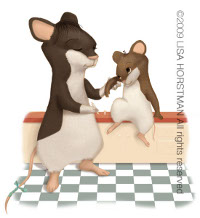 4. 7-Imp: If you could have three (living) illustrators—whom you have not yet met—over for coffee or a glass of rich, red wine, whom would you choose?
4. 7-Imp: If you could have three (living) illustrators—whom you have not yet met—over for coffee or a glass of rich, red wine, whom would you choose?
Lisa: Not an easy choice!
5. 7-Imp: What is currently in rotation on your iPod or loaded in your CD player? Do you listen to music while you create books?
Lisa: Yes, definitely. For me, music is a big part of making the art, but I don’t listen to music while I write, unless it’s instrumental. Right now I have…let’s see…Joe Strummer and/or The Clash, Los Lobos, Aimee Mann, Hoagy Carmichael, Elvis Costello, Billy Bragg, Django Reinhardt, Frank Black & The Catholics, The Decemberists, some old French accordian music from the 1930s, Gogol Bordello, and some Oscar Peterson thrown in for good measure. I also love finding new music via blip.fm or last.fm.
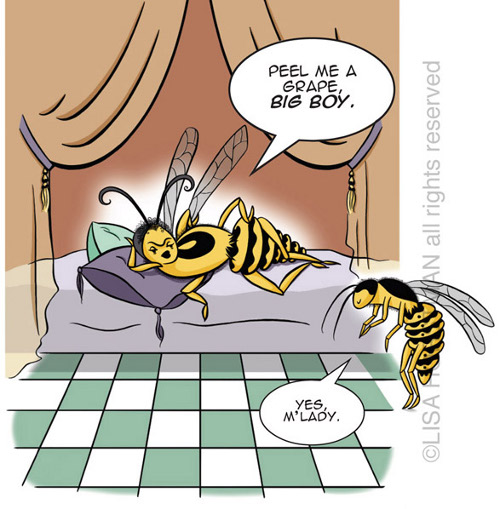
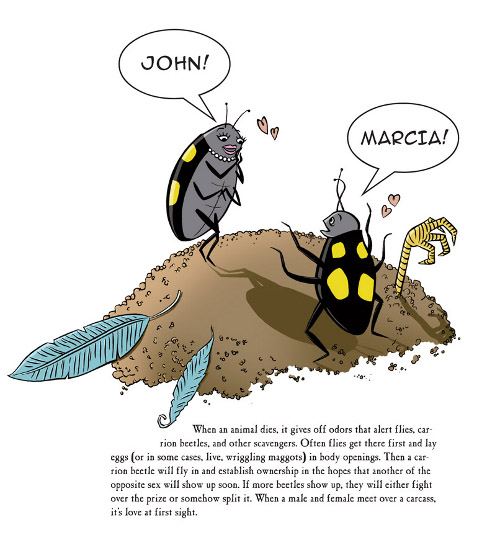
6. 7-Imp: What’s one thing that most people don’t know about you?
Lisa: I used to sing lead in musicals. Strangely, I can’t read music, but have an uncanny knack for picking up melody.
Lisa: I have a version of this on my web site, so I will turn on my alter ego and answer these a little differently for variety’s sake. Also, in a somewhat unrelated note, our cat, Thomas, looks like James Lipton, who asks these questions on Inside the Actor’s Studio.
7-Imp: What is your favorite word?
Lisa: “Balderdash,” closely followed by “poppycock.” Also, “paws.”
7-Imp: What is your least favorite word?
Lisa: It’s a curse word that begins with a “c.” It makes my ears collapse.
7-Imp: What turns you on creatively, spiritually or emotionally?
Lisa: Good ideas.
7-Imp: What turns you off?
Lisa: People who stifle creativity, whether their own or other people’s.
7-Imp: What is your favorite curse word? (optional)
Lisa: What, only one? I suppose it would be F-o-o-o-o-o-o-o-o-o-ck!
7-Imp: What sound or noise do you love?
Lisa: Stringed instruments.
7-Imp: What sound or noise do you hate?
Lisa: You know when kids are upset and they make that high-pitched scream? Yep, that’s pretty high on the list.
7-Imp: What profession other than your own would you like to attempt?
Lisa: Designer of Rube Goldberg-like devices.
7-Imp: What profession would you not like to do?
Lisa: Veterinarian. I can’t bear to see animals in pain, though it must be wonderful to help them.
7-Imp: If Heaven exists, what would you like to hear God say when you arrive at the Pearly Gates?
Lisa: “You can take that insulin pump off now.”
All artwork and photos (with the exception of the coffee mug and book covers) courtesy of Lisa Horstman. All rights reserved.
SQUAWKING MATILDA. Copyright © 2009 by Lisa Horstman. Published by Marshall Cavendish, Tarrytown, NY. Reproduced by permission of the author.


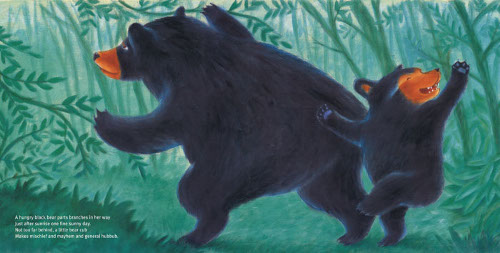
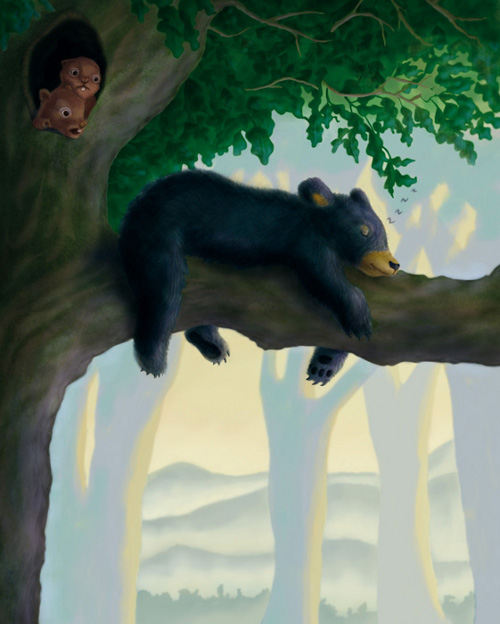
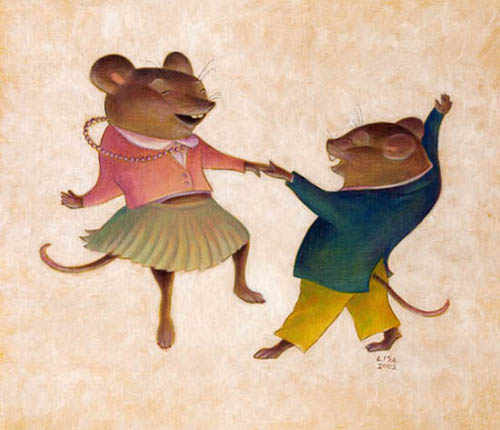


Fascinating, the process, the figures, the author, all of it. A wonderful post and interview. What an inspiration and what talent. Thank you for highlighting this author. Alice
Wow. Just wow. Fascinating process with the puppets! LOVE those monkeys (esp. the one with glasses), and the dog hat. Thanks for featuring this wonderful Tennessee author/illustrator (new to me)!
Holy cow! What amazing work and such meticulous detail. Now I feel like I don’t work hard enough.
Wow. I am just overwhelmed with Lisa’s myriad creative talents! What an amazing artist – is there anything she can’t do? Thanks for starting the day out on such an inspiring note, Jules!
So cool. I’m a 3-D illustrator too and have been finding myself adopting more and more clay animation techniques – very inspiring to see someone else using them so successfully. Thanks for an exceptional interview.
Frickin’ frackin’ freakin’ cool. Love these interviews.
I’m new to Lisa’s work. I love the way the puppets combine with the digital art, and “giving Cat a new hairdo” cracks me up. I find art where people construct things like puppets completely fascinating. It’s so different from the way my own mind works.
Also, I am always comforted to know that other grown-ups can find enough cat hair in their homes to build a new cat.
INCREDIBLE interview. This girl is amazing.
Another classic interview — and another classic interviewEE. Those puppets (how they’re made; how they look, once made; and how they’re used in the process) have got to be one of the coolest media for kids’ book illos!
And I really loved the “Is your cat weird?” question. Kids have a great and wholly innocent way of asking questions about one thing, while making a statement about another. 🙂
I particularly love (what I believe is titled) ‘Squawking Matilida”.
I keep thinking she’s a lucky little girl, living in the warm, yellow, moon, popping out now and then to run her fingers through the sky.
Don’t you love it when art makes you wonder what it might be like to sit inside the orbiting, round head of the moon…perhaps having a bit of tea as the earth goes by. : )
I was not familiar with Lisa Hortsman’s work before and now I can see that she’ll be a new and continued inspiration to me.
Liz
A perfectly lovely interview with a perfectly wonderful artiste! Of course, I’m biased, being one of Lisa’s 4 older siblings.
Something Lisa didn’t mention during the story–we often recognize people we know in the characters Lisa creates. And they’re usually morphed into animals!
It’s good to see other people’s reactions to Lisa’s work. We’re proud of our baby sis and glad she is inspiring others the way she has inspired us.
Pat
I just discovered you on the Cavendish website. OH MY GOODNESS you are a visionary genius. My first book 10 Turkeys in the Road is coming out in 2011 with Marshall Cavendish, I’m SO excited.
I am amazed by you and the work that you put into your books, and the whole insulin pump thing, I hear you. My daughter Stacie (11) has type one diabetes. It’s such a sucky disease. We have the pump but haven’t used it as of yet, she got a shot this morning and cried.
Normally she doesn’t even flinch. She’s had diabetes since 4. It’s such a hard disease and she has Celiac Disease too.
Anyway just wanted to give you a shout-out.
Best,
Brenda Sturgis
Thank you, everyone, for your kind comments. It makes the flat tire and dead battery on my car a little more tolerable to deal with this week! I’ll make more books if you want them.
[…] Wash, released by Simon & Schuster in July. Remember when East Tennessee author/illustrator Lisa Horstman stopped by in early July? I’ll say again: 7-Imp seems to have readers all over the world, but it’s […]
Rattling excellent info can be found on weblog . “The absence of flaw in beauty is itself a flaw.” by Havelock Ellis.